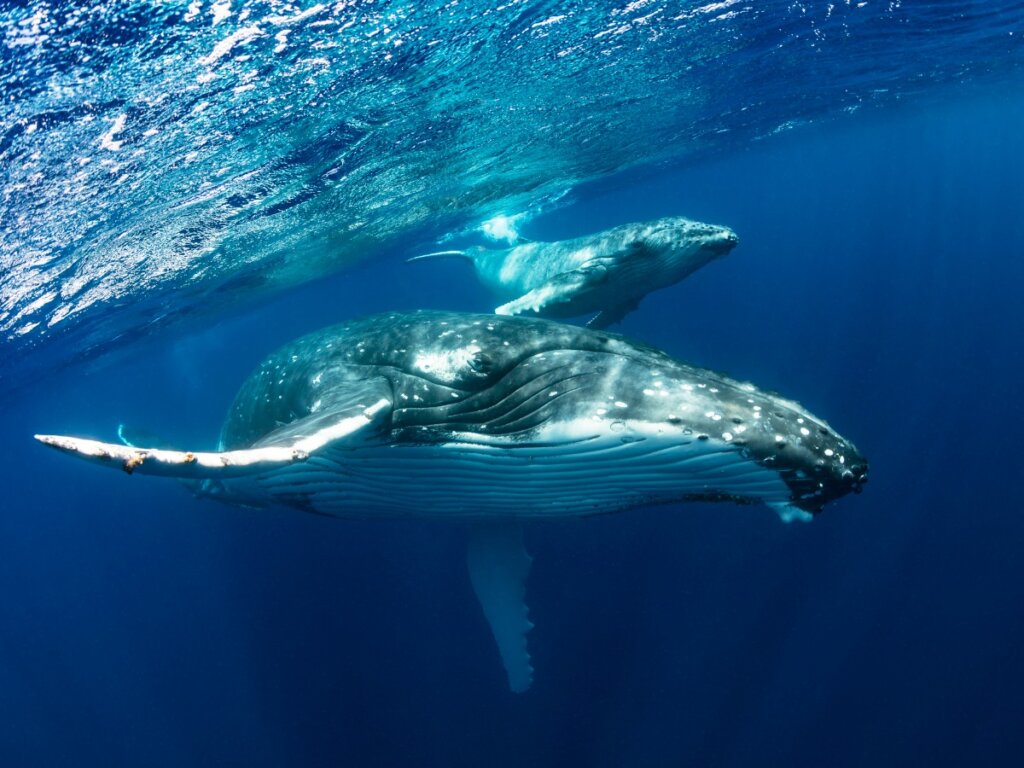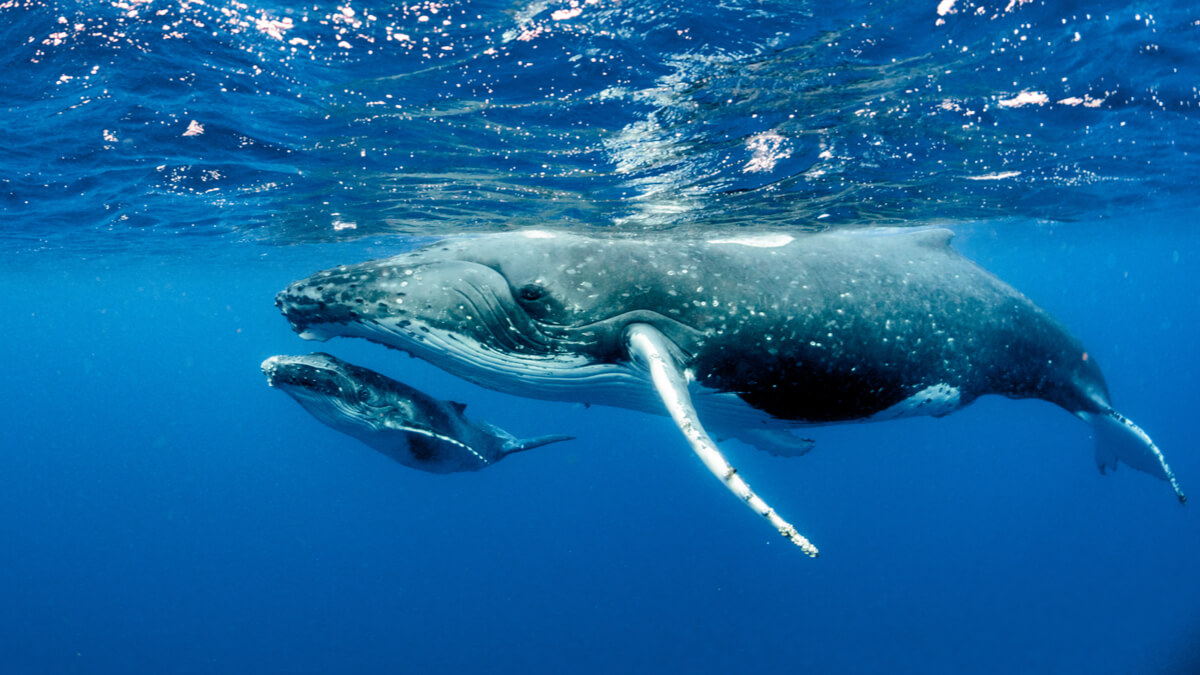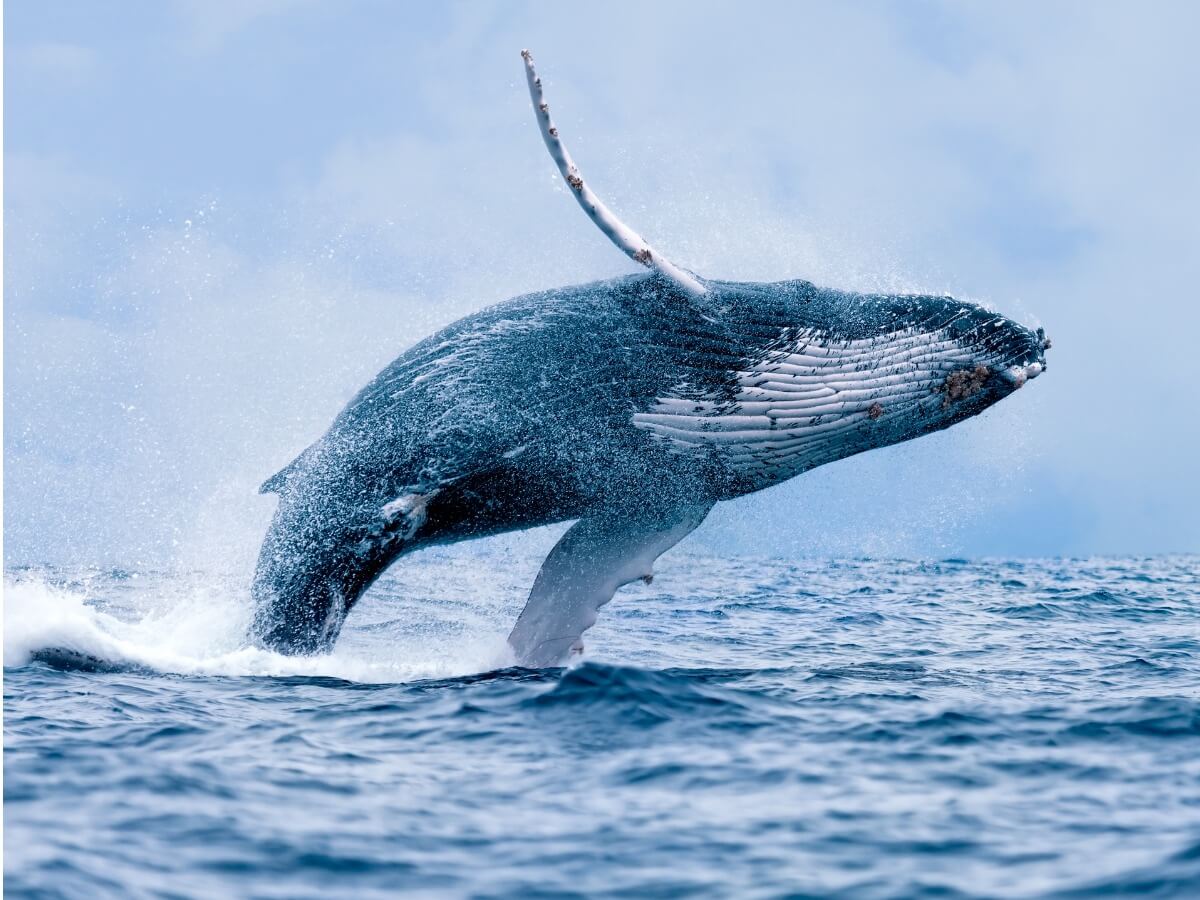Humpback Whale: Habitat, Characteristics and Behavior

The humpback whale, also known as the yubarta whale, is known for being able to jump several meters above the water. Its mysterious and beautiful whale song and its extraordinary migrations have fascinated people for decades. Researchers have been trying to decipher their language and behavior for many years, and each step they take leaves more questions than answers.
This cetacean belongs to the order of the mysticetes, or baleen whales, which, instead of teeth, have a different sort of filtering system. Its name comes from the pronounced dorsal curvature it exhibits when submerged in water, similar to a hump. If you want to know more about it, keep reading.
Humpback whale habitat
Humpback whales can be found in the waters of all oceans around the world, except for polar seas. Currently, there are three large populations of humpback whales: one in the North Atlantic, another in the Southern Hemisphere, and a third in the North Pacific.
When they aren’t migrating, these whales tend to stay close to the mainland, although they rarely approach areas populated by humans. You can also see them in the open sea when they go in search of large shoals of fish.
Physical characteristics
The humpback whale (Megaptera novaeangliae) belongs to the Balaenopteridae family, characterized by the gular folds that run through its ventral part, from the mouth to the navel. Its body is robust and it tapers significantly at the tail.
This species has hair follicles on both sides of the head, which look like a bump. Their pectoral fins are among the largest among the mysticetes, and are a third of their total size.
They’re black in the upper part of their body and the hues are lighter in the belly. Each individual has a unique mottling pattern on the ventral part of the tail, similar to a fingerprint.

Humpback whale size and weight
An adult humpback is 13 to 16 meters (42 – 52 feet) from head to tail and weighs 30-40 tons. It presents sexual dimorphism, the females being larger than the males. The specimens that live closer to cold areas tend to be larger than those that live closer to the tropics. There can be a difference of 20 tons between some groups and others.
Behavior and migration
It’s a gregarious animal, but it isn’t normal to see adult specimens in large groups. The most stable links are between mothers and children, as the males exhibit great rivalry. This is especially so in mating seasons— and not too many specimens tend to get together if it isn’t to feed.
On occasions, males can be observed escorting mothers with children, defending them from other specimens that approach them.
This species has a high degree of sociability, as humpback whales have been seen interacting with other species, such as seabirds and other cetaceans. They also stick their heads out of the water, presumably to have a look at what’s on the surface of the water.
Their communication is through vocalizations, longer and more complex in males and shorter and weaker in females. This has a direct relationship with the songs of the mating season, although they also use it to communicate between groups over long distances.
Humpback whales migrate twice a year, seeking the warmest waters and more abundant food. They spend their summers in the cold waters of high latitudes and move to the tropics to reproduce, traveling a whopping 25,000 kilometers per year (15,500 miles). During these trips, they don’t rest or eat, but are nourished by their own fat reserves.
The only whales that don’t migrate is those of the Persian Gulf, where the monsoon season ensures they have enough food throughout the year.
Humpback whale diet and feeding
The basis of the diet of this cetacean consists of krill, plankton, and small fish such as herring, capelin or mackerel. It feeds mainly in the summer to recover from the migration and prepare for the next one. As it doesn’t have teeth, it can’t prey on large animals, as it isn’t able to shred tissues.
Their hunting techniques aren’t limited to traveling shoals of fish; humpbacks exhibit really curious behavior patterns. Sometimes they create walls of bubbles by releasing air through their blowholes. In this way, they surround the fish and only have to swim towards them with their mouths open to swallow them in one go.
Humpback whale reproduction
They reach sexual maturity at 10 years of age. They mate every 2 years or so and the gestation period is 10-11 months.
During mating, males and females swim first in line and together, then turn and wag their tails. After that, they dive and copulate while swimming to the surface, belly to belly, ending with a vertical jump out of the water.
The young are about 4-5 meters long (13-16 feet) at birth and weigh about a ton. They remain with their mother for the first year or so, although sometimes they are fully weaned at 6 months. The mother’s milk is rich in fat, protein, and lactose and the calf consumes 400 liters (88 gallons) a day.
State of conservation
Currently, the humpback whale is in a conservation status of least concern. Experts estimate that there are around 6,000 specimens — a figure that seems to be rising — although, before human exploitation, there were an estimated 100,000.
More than 60,000 humpback whales died between 1910 and 1916 in the southern hemisphere. In the North Pacific, maximum catches of more than 3,000 were recorded between 1962 and 1963.
Whaling was banned globally in 1970, but Japan, Norway and Iceland hunt whales in their waters despite this. At present, the fight against this hunting is combined with the protection of the environment. This is because climate change, unsustainable fishing and oil exploration are the main threats to these cetaceans.
During the 2020 confinement due to COVID-19, whales were sighted off the coasts of Chile, Argentina, La Palma, the Canary Islands and Marseille. The absence of human beings allowed the waters to be cleaned and the whales to enter territories that haven’t been theirs for a long time.
Humpback whale relationship with man
The intensive hunting of the humpback whale was aimed at obtaining its blubber and meat for consumption. Also, their crushed bones served as fertilizer. Currently, the fascination for these cetaceans has also promoted tourism, where boats approach their habitat to see them jump out of the water.
On the other hand, as they’re such enormous animals, whales populate the collective imagination of many cultures. They’re often associated with chaos and unrestrained fury, but also with the protection of the sea and the creation of the world.
The oldest known representation of a whale comes from a cave in Norway and dates from around 1800 BC. In it, hunters chase a huge creature that shoots a stream of water from the top of its head.

At present, the most effective form of awareness is through the dissemination and creation of conservation projects. The hope of being able to give these mystical and scientifically fascinating beings back their space and see them live in peace is something we should all be aiming for.
All cited sources were thoroughly reviewed by our team to ensure their quality, reliability, currency, and validity. The bibliography of this article was considered reliable and of academic or scientific accuracy.
- Ballena jorobada (Megaptera novaeangliae). 2018. Megaptera novaeangliae . La Lista Roja de Especies Amenazadas de la UICN 2018: e.T13006A50362794.https://dx.doi.org/10.2305/IUCN.UK.2018-2.RLTS.T13006A50362794.en . Descargado el20 de junio de 2021.
- Perrin, William F.; Wursig, Bernd; J.; Thewissen, G.M., ed. (2008). Encyclopedia of Marine Mammals(en inglés) (2 edición). Academic Press. p. 583. ISBN 9780123735539.
- Megaptera novaeangliae (humpback whale). (2021). Animal Diversity Web. https://animaldiversity.org/accounts/Megaptera_novaeangliae/
- Weinrich, M. T., M. R. Schilling, and C. R. Belt. Evidence for acquisition of a novel feeding behaviour: lobtail feeding in humpback whale, Megaptera novaeangliae.Animal Behaviour, 44(6):1059-72.
- A. (2021b, abril 20). Conservación de las ballenas y cambio climático | Fundación Aquae. FundaciÃ3n Aquae. https://www.fundacionaquae.org/conservacion-ballenas/
- Multiple humpback whale singers chorusing(2018). Plos One. https://figshare.com/articles/figure/Fig_S6_Multiple_humpback_whale_singers_chorusing/7403738